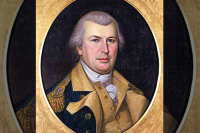The Bascom puts a twist on art, craft exhibits
Hearing The Bascom being called a world-class facility might seem a stretch until you pay a firsthand visit to the six building, six-acre campus in Highlands. Then, however, the words seem entirely appropriate and scaled to reality.
The Bascom is a center for the visual arts created in 2009. The nonprofit doesn’t have a large private collection of works; the center instead focuses on providing top-notch exhibitions primarily garnered from across the Southeast. Six exhibitions were held last year. These included shows featuring glass artist Richard Ritter, painter and printmaker Frank Stella and ceramics maker Ben Owen.
The advantage to artists showing in this well-heeled, upscale Highlands market is huge: The Owen’s show, featuring the Seagrove potter’s signature pieces, almost completely sold out, The Bascom’s Ezra Gardiner said.
That kind of track record helps The Bascom lure a caliber of artists few other similar-sized facilities can boast of attracting.
Some of the highlights this year include an exhibition of paintings by Art Rosenbaum and the large-scale, kinetic sculpture of suspended ceramic discs that are mounted and hung from the ceiling by artist Tim Curtis. There also will be an exhibit titled “Her Impressions” featuring paintings by women during the Impressionism movement using works on loan from a number of Southeast museums and institutions.
There’s one important point about The Bascom that people working at the center are eager to make. The center takes great pride in putting what Executive Director Jane Jerry calls “The Bascom twist” on exhibits while they are displayed here.
Related Items
“You can only do that with a small institution like this,” said Jerry, who has led The Bascom for about a year.
What does “The Bascom twist” entail? For his part, Gardiner described the twist as “putting a spin on it” by showing artists’ pieces in a manner that is unique and design rich — from the manner in which the pieces are placed and lighted for viewing to drawing on the attributes of the facility itself. Most of the shows are curated in-house by staff, and during the summertime are displayed for eight-week periods at a time. Big exhibitions are in the main gallery, smaller ones in a loft gallery upstairs from the primary viewing area.
Much of “The Bascom twist” is truly the setting of the facility itself: you enter the center through an 87-foot by 14-foot, 53-ton covered bridge transplanted to WNC from New Hampshire.
Once on campus, the main building is 27,500 square feet of museum-quality space made of hand-hewn, post-and-beam barn pieces accentuated with modern stone and glass. Even the floors are unstained white pine re-purposed from several historic barns. There also is a studio barn, a rebuilt rough-hewn barn complete with studio spaces for pottery and three-dimensional arts instruction.
So much of “the twist” is the fact that the paintings, ceramics, metal work and glass pieces are shown in a backdrop that is truly unique.
Understanding the community
Setting up and running The Bascom probably wouldn’t be possible in WNC outside of a venue such as Highlands, where the residents are affluent and visibly supportive of the arts. In addition to The Bascom, this is a community that can boast of the Highlands Playhouse, the Highlands Cashiers Chamber Music concerts, the American Museum of Cut and Engraved Glass and the Instant Theater Company, featuring improvisation.
“Highlands and the whole plateau area is different from other communities,” Jerry said. “I’m so new, it has taken me a while to understand the profile of donors and funding sources here.”
The Bascom, in becoming The Bascom, has successfully tapped more than 800 sources — corporations and foundations but mainly individual — in paying about $9 million of the $13 million in its construction campaign. Fundraising continues for this new facility, and for a separate educational and exhibitions program endowment.
Jerry said The Bascom, in comparison to most galleries and art centers featuring the caliber of artist being exhibited here, is so small “we just haven’t had a lot of government support — mainly individual.”
The Bascom has a mortgage on the property that the nonprofit is in process of paying off. And with a board of directors totally committed to offering free admission to the arts, fundraising is key to the facility’s current and future wellbeing.
“I don’t want to sugarcoat the idea that this isn’t an ongoing challenge. We are raising money all of the time,” said Jerry, adding that fundraising “is the job” for any manager of a nonprofit.
Jerry was most recently the project-planning director for Exploration Station, the Republic of Ireland’s first interactive science center. Prior to her stint in Ireland, Jerry was the president and CEO of Cheekwood Botanical Garden and Museum of Art in Nashville, Tenn. She’s no stranger to fundraising challenges: During her tenure at Cheekwood, Jerry led a capital campaign that resulted in an $18.5 million investment in the garden and facilities, and the Cheekwood Museum of Art attained accreditation by the American Association of Museums.
The Bascom has three main benefit events: a wine festival in May; a garden festival in July; and an art, design and craft show in October. It also has an extensive membership of 946 people, plus 300 or so volunteers who provide a veritable army of help to the 10 paid staff members.
Jerry said that she has spent this first year trying to be “a really good listener, and to understand The Bascom and its place in this community. And to work as hard as I can to begin to define a vision for the future that is a reflection of what this community wants.”
One thing the community clearly wants is a tangible connection with The Bascom. Outreach programs make that connection, plus appeal to donors, Jerry said. Among the upcoming programs this spring is a partnership with the Highlands Literacy Council’s after-school art program. This focuses on sea life and will result in an “Underwater” exhibit being installed in the fall.
The Bascom also partners with the local food pantry and with other groups as part of its outreach programs, plus provides scholarship money and free family memberships to the facility.
The Bascom history
The Bascom exists because of artist Watson Barratt, a part-time Highlands resident who died in 1962, who wanted to establish a permanent gallery in his seasonal home to display works by regional artists. His bequest made exhibition space at the Hudson Library in Highlands possible starting in 1983. The then Hudson Library building incorporated proceeds from the estate and included a dedicated space for the Bascom-Louise Gallery.
In 1999 the two entities separated. The art center attained nonprofit status, formed a board of directors, wrote bylaws and hired staff. In 2009, The Bascom moved to its new campus.
Source: The Bascom
At The Bascom
• “Chick’s: It’s All Gone to the Birds,” March 31-June 17.
• Alex Matisse: “Ometto,” May 12-Oct. 1.
• “Green Art:” May 17-July 8.
• “Her Impressions:” June 23-Sept. 16.
• “Bascom Members Challenge, Couples:” Aug. 18-Oct. 14.
• Art Rosenbaum: “Voices,” Sept. 1-Nov. 10.
• American Craft Today: Sept. 22-Dec. 29.
• “Giving Trees:” Nov. 17-Jan. 1.
www.thebascom.org for additional details. Admission is free.









